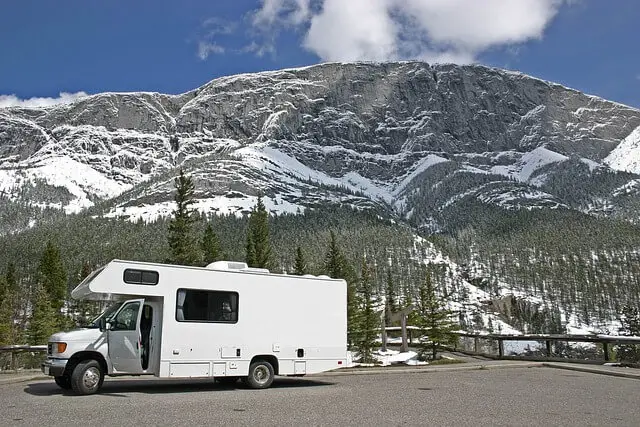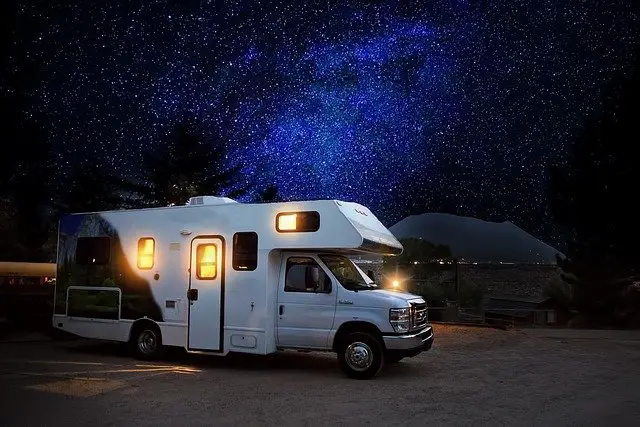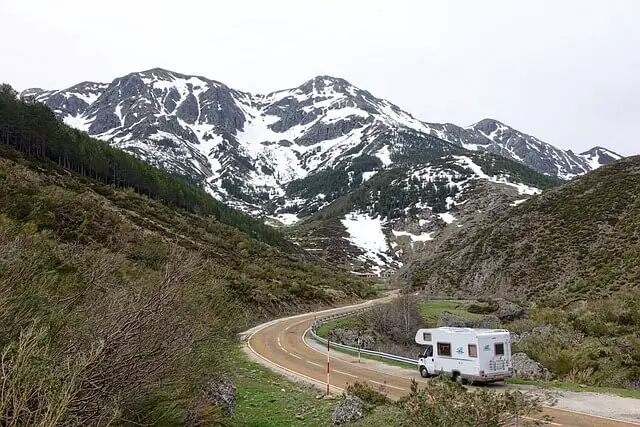Even though many people prefer camping in warm weather for convenience, it is possible to camp in cold weather too. Many people take their campers to remote locations during the winter. There is something special about seeing all-white scenery and enjoying the peace and quiet of winter.
But can you actually travel in the winter with a camper? Do you need to insulate it, and how would you do that? If these are questions you find yourself asking, you have come to the right place!
Today’s guide will tell you all about the easiest and most cost-efficient ways to insulate your camper. There will be helpful tips and tricks you can use before any winter camping trips, so make sure to pay a lot of attention. If that much is clear, let’s get right into the article!
More...

Table of Contents
Can I Use My Camper in the Winter?
It is possible to use a camper for any camping trip during winter. Some campers come with a special winter package that makes them perfect even for trips in freezing weather.
Suppose your camper does not have the winter package. In that case, camping will be more difficult for you as you will need to spend a lot of time insulating all openings, floors, vents, plumbing, and so on.
How Cold is Too Cold for a Camper?
There is no such thing as too cold weather for a camper with great insulation and all-around protection. You can take such a camper to a campsite even if the temperatures go below zero degrees Fahrenheit.
In that case, you have to be extra careful and insulate the plumbing, opening, and water tanks, so they would not freeze. A general recommendation is to avoid camping below -20 degrees Fahrenheit, but anything above that should be okay.

How to Insulate a Camper for Winter Use [12 Useful Tips]
Camping becomes less enjoyable when the weather turns cold because there is only so much you can do to warm yourself in a camper. It is different from staying warm in a home because houses and apartments generally have better insulation to begin with.
With campers, things are a bit different. You can surely insulate them and make them comfortable for winter trips, but you will have to do the work. Here are some of the things you can do as a way to insulate your camper and make it suitable for winter living or traveling:
Install multi-pane windows
Older campers come with regular one-pane windows. Those windows do not make a difference when camping in warm weather. You can enjoy the lovely window scenery without worrying about the insulation. But things change when winter comes around.
One-pane windows do not provide good insulation. The older they are, the more likely they will let cold air enter the camper. They will also allow the warm air to escape, meaning that you will be heating the camper for nothing.
If the one-pane windows do not work, you should consider replacing them with multi-pane windows. Installing them will take a bit of work, depending on how good you are with the tools. If you cannot manage to install them yourself, you can also have a handy person help you out with that.
Seal the windows
Sometimes, the type of window you have will not make much difference if worn out. Even the best multi-pane windows do not last forever. After much wear and tear, they will start letting air move through them or the space between the window and its frame.
If you notice that your camper windows allow a slight breeze to enter your camper, you will need to seal them. Sealing is a great option for people who cannot buy new windows to replace the old ones completely. Sealing the windows will be less costly but will fix the problem quickly.
You can buy any sealant kit that you like or is recommended to you at the store. You can also get a shrink kit. Both options will include an insulation film that you will use to cover the window. Then, using special tape, you will secure the film in place.
Use window covers
If sealing or replacing RV windows is not an option, you can always use window covers to improve insulation. Buying new windows is a bit of an investment. Sealing your windows can take a long time, but it might be ineffective. The safest way to go is by using a simple window cover.
There are various covers you can find on the market. Thermal curtains are best because they are very effective at preventing air movement. That means no warm air is going out and no cold air is entering.
Did you know that you can also use these covers during summer to keep the hot air from getting into your camper?! You get double the benefits for half the cost of other insulation methods.

Install RV skirting
As funny as it may sound, you can use skirting to insulate your camper. No, you will not be adding an actual skirt to your camper – just something that bares a similar name.
The process of skirting can be confusing to people who do not know anything about it. The method includes adding insulation on one part of the camper, usually the back. The insulation can be a foam board or plastic sheeting, depending on your choice.
Skirting is something I recommend to people who know what they are doing. If you have never applied something similar, you will waste a lot of time adding the RV skirt.
The good thing is that you can always buy custom-made skirting and have a professional attach it to the camper. The investment will be worth it because you will get great insulation afterward.
Seal the slide-outs
Slide-outs or slides for campers are moving parts that allow you to expand the camper’s space. They are very convenient and easy to use but are somewhat difficult to keep warm. This is partly because most slides have poor insulation, so you need to insulate them yourself.
Slides are usually easy to insulate, which is a good thing. You can choose between foam boards, insulated blankets, or a rubber conditioner to insulate a slide-out. The insulation material will cost some money, and it will take some time to install everything, but everything will be worth it.
Another thing to remember is that slide-outs need regular maintenance to stay in top shape. So, you will need to check them often and replace or reseal every part that has been damaged or worn out. If you do this often, you are more likely to extend the insulations’ longevity.
Use a door snake
Door snakes are not only suitable for campers but also for your home. They are an effortless and convenient way to insulate your door, while they are not even that costly. Anyone can afford to get them and use them to better the room’s insulation.
Door snakes come in various sizes and from different materials. You can have custom-made door snakes for your camper. Whenever winter comes around, you will need to apply them to the door, and they will keep the cool air out.
Door snakes offer great insulation because they do not allow air to pass through them. Within the actual “snake” is a tube filled with material. Apply the tube to the door line, and you will be good to go as the camper or room will be fully insulated.
Wrap the door
If you do not have door snakes you can use, you can always wrap your door as a way to insulate it.
Doors allow air to pass through them easily or through the space between the doorframe and the actual door. That is why you must be careful and remember to insulate all doors when preparing your camper for winter.
You can wrap the door with bubble wrap, plastic, or thermal insulation. The latter will be a bit more expensive, but it is bound to be more effective. Whatever option you choose, wrap the entire door and not leave any open spots.
Install fiberglass insulation
When camping in freezing temperatures, you will notice that the walls also get very cold. When you sit next to them or try to touch them, they will leave you feeling frozen. This should be enough to show you that you also need to find a way to insulate the walls.
One of the most effective ways to insulate camper walls is by applying some fiberglass insulation. This is by no means easy or cheap, but it is necessary for people who want to try winter RV living.
With the fiberglass installed, you can heat the inside of the camper using a small space heater. Be careful, as there will be quite a difference between the outside and inside temperatures. You want to avoid shocking your body by going directly from the warm campers to subzero temperatures outside.
Seal ceiling vents
As I have mentioned thus far, a camper involves insulating the windows, doors, walls, and slides. I have yet to mention that you also need to insulate the roof vents because they can significantly affect the temperature.
When heating the inside of a camper, you must be aware that the heat rises toward the camper’s roof. If the vents are worn out or damaged, they will let the hot air escape through them. To keep the camper warm, ensure the vents are in top shape and sealed shut.
Cover the plumbing
The RV’s plumbing system will likely freeze in sub-zero temperatures. RV pipes can suffer damage when not protected from the cold. If they are exposed, they are even more likely to freeze.
You need to cover or add insulation to all RV pipes. You can place thermal blankets over the pipes or add heating cables along them. Apply the same insulation to the water heater and tank and keep them full at all times, as they are less likely to freeze that way.
Insulate the floor
To prepare a camper for winter use, you need to insulate the floor. While adding any insulation layer to the floor can also use a few rugs to make it warmer. Just make sure that the rugs are made from some thick material.
If you have a bed or any seating arrangement that is placed on the floor, you can go the extra mile and insulate it. Adding a heated mattress pad or a heated blanket will do the trick.
Insulate the storage units
Some campers have special storage units on the bottom, under the floor. Such storage units are convenient as they do not take up space from the camper. Still, they come with some disadvantages as they are a nightmare to insulate.
You will need to block cold air from getting to the units by adding some extra insulation all over the units. It can be thermal blankets, plastic sheeting, foam boards, or even regular insulation boards. These options prevent the cold air from getting to the camper through the storage units.
If there are other things on the bottom of the camper, go ahead and insulate them too. The RV underbelly, extra tanks, or even exposed tires can freeze and become unusable. You must keep an eye on them when taking winter camping trips.

Wrap-Up
If you do not insulate and protect your camper, you must endure the cold temperatures while staying at a campsite. To prevent this and all possible side effects of camping in the cold, I recommend putting all advice given above to good use. Trust me, you can only benefit if you go the extra mile and insulate your entire camper!
- Are Merrell Shoes Good? – An Unbiased Review of Merrell Footwear - December 9, 2023
- Where Are Merrell Shoes Made? - December 9, 2023
- Camping in 40-degree Weather: Tips and Tricks - September 25, 2023

![How to Insulate a Pop-Up Camper? [6 Great Ways] How to Insulate a Pop-Up Camper? [6 Great Ways]](https://grandcircletrails.com/wp-content/uploads/2022/11/How-to-Insulate-a-Pop-Up-Camper-150x150.jpg)
![How to Get Burrs Out of Clothes? [Most Effective Ways] How to Get Burrs Out of Clothes? [Most Effective Ways]](https://grandcircletrails.com/wp-content/uploads/2022/06/How-to-Get-Burrs-Out-of-Clothes-150x150.jpg)
![How to Inflate an Air Bed without a Pump? [Most Effective Ways] How to Inflate an Air Bed without a Pump? [Most Effective Ways]](https://grandcircletrails.com/wp-content/uploads/2022/07/How-to-Inflate-an-Air-Bed-without-a-Pump-150x150.jpg)

![What Smell Do Mosquitoes Hate The Most? [11 Things Mosquitos Hate] What Smell Do Mosquitoes Hate The Most? [11 Things Mosquitos Hate]](https://grandcircletrails.com/wp-content/uploads/2022/04/What-Smell-Do-Mosquitoes-Hate-The-Most-1-150x150.jpg)
![Can You Use a Propane Heater in a Tent? [Is It Safe?] Can You Use a Propane Heater in a Tent? [Is It Safe?]](https://grandcircletrails.com/wp-content/uploads/2022/06/Can-You-Use-a-Propane-Heater-in-a-Tent-150x150.jpg)